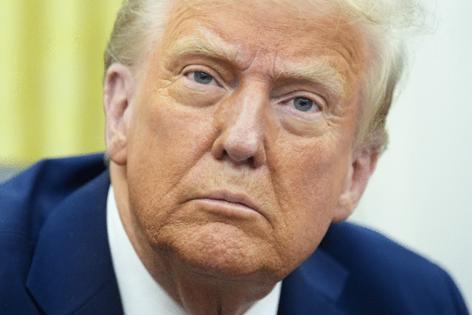Trump set to unleash first of many tariffs promised globally
Published in News & Features
WASHINGTON — President Donald Trump is preparing to fire the first salvo of his tariff war and can hardly wait to preview the next one.
Trump is set to formally announce general tariffs of 25% on Canada and Mexico, and 10% on China, on Saturday at Mar-a-Lago, his Florida estate. The countries are the largest three sources of U.S. imports, accounting for almost half of total volume.
Trump has long threatened the tariffs, though teased the possibility of reprieve if Mexico and Canada took steps to control the flow of migrants and illegal drugs across their borders. Both did, but it wasn’t enough. Trump said flatly this week he’d proceed, and said Friday there was nothing the countries could do to stop him.
Trump is no stranger to tariffs though his admiration for them has reached new heights. He’s threatened to raise the Canada, Mexico and China tariffs further, promised similar levies on the European Union — “absolutely,” he said Friday — and vowed additional sectoral tariffs on steel, aluminum, copper, semiconductors and pharmaceutical drugs. He’s also weighed an across-the-board global tariff and mused about raising $1 trillion in annual new tariff revenue.
The moves will test so many barriers — the limits of his honeymoon period in his second term in the White House; of the US economy and its fledgling victory over inflation; of American consumers’ appetite to swallow fresh price increases; of the patience of allies. Tariffs are paid by American importers and borne by consumers, though offset potentially by price reductions abroad. But, for Trump, they’re a philosophy, with him yearning for an era a century ago when U.S. coffers were funded by tariffs and not income taxes, saying his measures will reinvigorate industry.
“The way you bring it back to the country is by putting up a wall. And the wall is a tariff wall,” he said. “The tariffs are going to make us very rich and very strong.”
The nonpartisan Congressional Budget Office has put the cost of extending the 2017 tax cuts — Trump’s top legislative priority — at $4.6 trillion over 10 years. A 25% tariff on the more than $900 billion in annual imports from Canada and Mexico would raise roughly $225 billion annually or $2.3 trillion over 10 years if the tariffs had no impacts on trade, which many economists see as unlikely.
Barring a surprise last-minute reversal, he said Friday he’ll impose the tariffs on Canada and Mexico at 25%, while reducing the levy on imports of Canadian oil to 10%. China’s overall new tariff will be 10%.
The move against Canada and Mexico is a signal that no country is safe from his push to reshape global trade. The countries are the top buyers of US goods and have a continental free trade pact signed by Trump himself. The tariffs fly in the face of that.
They’ve pledged a response. Canada is promising retaliatory tariffs of its own, and even weighed an export tax on oil to undercut Trump’s ability to exclude gasoline price hikes from his tariff fight. Mexico’s president has hinted her country could respond with a retaliatory tariff, but never gave details about the possible plan. Both Canada and Mexico are still pressing to avoid implementation of the tariffs altogether; Trump, asked Friday if there’s anything they can do, said “no, nothing.”
Trump also said Friday that he’d announce, in the next month or so, new tariffs on steel and aluminum, which he applied levies to in his first term. He didn’t specify the new level but said it would be lucrative for the government. He also said he’d impose a tariff on copper, offering no details but saying it would take longer than steel and aluminum.
He said he’d tariff semiconductor chips — repeating that vow after his meeting Friday with Nvidia Corp. Chief Executive Officer Jensen Huang. He’s also pledged a tariff on pharmaceutical drugs, without specifying which, at what level or when it would take effect.
The Association for Accessible Medicines industry group, in a statement by Chief Executive Officer John Murphy III, sounded the alarm earlier this week about the “devastating impact tariffs on generic and biosimilar supply chains would have on American patients and the US healthcare security in general.”
Trump also suggested Friday he’d consider new tariffs on oil and gas, potentially by Feb. 18, though it wasn’t clear what he was referring to.
The final details of Trump’s first tranche of tariffs aren’t entirely clear. It doesn’t appear there will be exemptions, though companies and industries are sure to seek them. He said the various tariffs would stack upon one another — meaning, for instance, that a Mexican steel company might pay more than a firm there that produced a different product.
Trump regularly says “tariff” is among his favorite words, behind only love, religion and God, and yearned for the fiscal system of a century ago where major tariffs were both a major income source and deeply politically unpopular. He credits President William McKinley at the turn of the 20th century as a trailblazer for the levies.
The fight is occurring against the backdrop of talks among Republicans for tax reform bills, which they’re aiming to pass in one or two bills without Democratic votes. A key pillar of that effort is extending expiring tax cuts and enacting new ones that Trump has promised, both of which will expand the already significant budget deficit.
Republican Sen. Kevin Cramer of North Dakota expressed concern in a social media post on Friday.
“The U.S. and Canada have a strong bond, which is why I’m confident we’ll quickly reach a resolution on tariffs,” he said.
Peter Navarro, a Trump trade adviser, told CNBC on Friday that the tariff effort can replace the revenue of tax cuts.
“Tariffs can easily pay for that,” Navarro said. “President Trump wants to move from the world of income taxes and countless IRS agents to the world where tariffs, like in the age of McKinley, will pay for a lot of government that we need to pay for and lower our taxes.”
———
(With assistance from Raeedah Wahid, Maya Averbuch and Shawn Donnan.)
©2025 Bloomberg L.P. Visit bloomberg.com. Distributed by Tribune Content Agency, LLC.







Comments